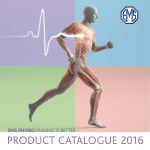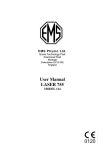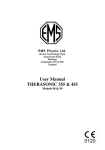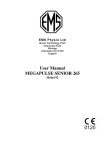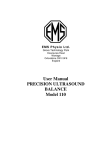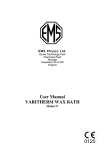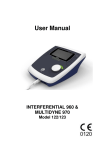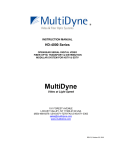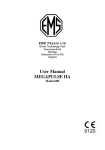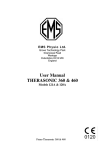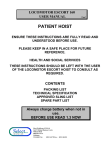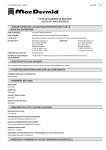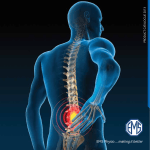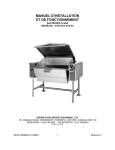Download User Manual VACUUM 655
Transcript
E M S P h ys i o L td . Grove Technology Park Downsview Road Wantage Oxfordshire OX12 9FE England User Manual VACUUM 655 Model 115 2 Vacuum 655 General Information This manual provides the necessary information for the installation and operation of the Vacuum 655 unit. These instructions must be studied before putting the unit into operation. The information contained in this manual is subject to change without notice. No part of this manual may be photocopied, reproduced or translated into another language without the prior written consent of EMS Physio Ltd. The Vacuum 655 unit is designed for use with the Interferential 955 and 960 and the Multidyne 965 and 970 units. The Vacuum 655 unit provides a convenient form of electrode application for interferential therapy. The cup electrodes with their sponge inserts are held in place by a partial vacuum. Both the vacuum and the electrical connection to each cup are provided by a single lead. It is intended that the Vacuum 655 unit is only used by qualified healthcare professionals such as physiotherapists who have received training in electrotherapy. Record of Amendments ISSUE 1 2 3 4 5 6 COMMENTS Initial Issue Revised Company Name Revised EMC Tables added Essential Performance list added Declaration of conformity updated Vacuum 655 DATE 14/12/2005 14/09/2006 01/10/2007 31/01/2008 16/09/2010 31/09/2012 3 EC Declaration of Conformity EMS Physio Ltd Grove Technology Park Downsview Road Wantage Oxfordshire OX12 9FE United Kingdom Declares that the following medical device is in conformity with the essential requirements and provisions of Council Directive 93/42/EEC and is subject to the procedure set out in Annex 2 of Directive 93/42/EEC under the supervision of Notified Body Number 0120, SGS United Kingdom Ltd. Class IIa according to Annex IX of 93/42/EEC Product Name Vacuum 655 Model Numbers 115 Signature 4 Position Quality Assurance Manager Date 30 September 2012 First issued 14 December 2005 Vacuum 655 Contents page 1 Title General Information 3 Record of Amendments 3 Declaration of Conformity to 93/42/EEC 4 Contents 5 Warranty 6 Introduction 7 Contraindications 7 Technical Specification 8 Controls and Markings 10 Installation 14 Operating Instructions 16 Maintenance 18 EMC Tables 19 Vacuum 655 5 Warranty EMS Physio Ltd., (hereinafter called the company) product is warranted against defects in materials and workmanship for a period of two years from the date of shipment. The Company will at its option, repair or replace components which prove to be defective during the warranty period, provided that the repairs or replacements are carried out by the Company or its approved agents. The Company will consider itself responsible for the effects on safety, reliability and performance of the product:only if assembly operations, re-adjustments, modifications or repairs are carried out by persons authorised by it, only if the product is used in accordance with the instructions for use, only if the electrical installation of the relevant room complies with the appropriate national requirements. Should the product be returned to the Company for repair it must be sent carriage paid. Consumable items, for example, electrodes, electrode covers and batteries, are excluded from the above warranty. 6 Vacuum 655 Introduction The Vacuum 655 unit provides a convenient form of electrode application for interferential therapy. The cup electrodes with their sponge inserts are held in place by a partial vacuum. Both the vacuum and the electrical connection to each cup are provided by a single lead. This method of electrode application is particularly suitable when treating relatively flat, smooth areas of the body such as the back where the cups may be attached quickly and easily. Also, this method is useful when treating relatively immobile patients, as the electrodes may be applied with the patient in a comfortable position without having to be moved for the application of velcro bandages. With the Vacuum 655 unit the vacuum may be set to a convenient and comfortable level with a front panel control. Connection to an interferential unit is made from the socket on the front of the Vacuum 655 unit, using the link lead provided. Two or four pole electrode applications may be used. Both the vacuum and electrical connections are switched by the vacuum unit. A pulsed vacuum mode is provided to further reduce the likelihood of bruising due to the vacuum. Two pulse rates are provided. Contraindications Vacuum electrodes should not be used on elderly patients with thin papery skin leading to contact difficulty and bruising. Vacuum electrodes are not suitable for patients who are taking steroids because of the likelihood of bruising. Vacuum 655 7 Technical Specification General Power Input Classification (EN60601-1) Mains Fuses Size (height x width x depth) Weight Vacuum Vacuum Modes 100-240 Vac 50/60 Hz Class 1, Type BF 2 x T630 mA (5 x 20 mm) 65 x 210 x 190 mm (excluding water trap) 1.5 kg 0 – 0.5 bar Continuous, Pulsed – 1 s period Pulsed – 2 s period The Vacuum 655 unit is designed to operate from any 50/60 Hz single phase supply between 100 and 240 Vac capable of supplying 70 VA. Connection is via an IEC socket at the rear of the unit. All information on model, serial number, and month/year of manufacture is located on the rear panel. Each Vacuum 655 unit is supplied with a detachable mains cable, spare fuses, a set of four 60mm suction cups and suction leads, a link lead for connection to an Interferential 955 or a Multidyne 965 unit and this manual. The Vacuum 655 unit has been designed to meet the requirements of BS EN 60601-1:1990 (BS5724:Part 1:1989) "Medical Electrical Equipment, Part 1:General requirements for Safety". Environmental Conditions for Transport and Storage Temperature -10 to +35 C Relative Humidity 5 to 95% Atmospheric Pressure 500 to 1060 hPa 8 Vacuum 655 Accessories Catalogue Number PMA3066 SLA3066 SLA3067 NC3068 NC3068A NC3069 NC3069A NC3070 EMS157 Description Link Lead to Interferential 960 or Multidyne 970 Link Lead to Interferential 955 or Multidyne 965 Link Lead to connect to Medi-Link Interferential Pair of 60mm suction cups (one yellow, one blue) Pair of sponge inserts for 60mm suction cups Pair of 100mm suction cups (one yellow, one blue) Pair of sponge inserts for 100mm suction cups Set of 4 suction leads SoLo Treatment Trolley Supplied with each unit is a detachable mains lead complete suitable for the country to which it is delivered. Replacement or additional mains leads are shown below. EMS Part Number 6-85 6-112 6-119 Description UK mains lead European mains lead North America mains lead For other countries contact EMS Physio or the agent from whom the unit was purchased. Environmental At the end its life, the Vacuum 655 should not be disposed of as unsorted general waste. Advice on appropriate disposal is available from EMS Physio Ltd. Vacuum 655 9 Controls and Markings Vacuum 655 front panel IEC Symbol 348 Attention, consult accompanying documents Power indicator IEC Symbol 878-02-25 Clockwise rotation increases vacuum Vacuum switch IEC Symbol 878-01-36 Input Output switch Input Socket IEC Symbol 878-02-03 Type BF Equipment IEC Symbol 878-02-08 "OFF" position of vacuum control The indicator lights above the vacuum and output switched show the current selection. The input socket is for connection to an interferential unit or muscle stimulator. 10 Vacuum 655 Vacuum 655 rear panel Water trap CE mark showing conformity to 93/42/EEC Model number and classification Serial number and date of manufacture Name and address of manufacturer IEC symbol 348 Attention, consult accompanying documents Mains connection is via the IEC socket on the right of the rear panel. Details of the required mains supply are above the connector. Vacuum 655 11 Vacuum 655 output panel Channel A suction outputs IEC Symbol 878-02-03 Type BF Equipment 12 Channel B suction outputs IEC Symbol 878-01-37 Output Water trap IEC Symbol 348 Attention, consult accompanying documents Vacuum 655 Vacuum 655 Accessories Link Lead (SLA3066) Suction Lead (2 blue, 2 Yellow NC3070) Suction Cup (2 blue, 2 Yellow 2xNC3068) Vacuum 655 13 Installation Upon receipt, check for any visible damage which may have occurred in transit. If any signs of damage are found then retain all packing material and inform the carrier and the Company or its agent from whom the unit was purchased. If not already fitted, connect a suitable plug to the mains cable. The plug must have provision for an EARTH (GROUND) connection. The mains cable has the following colour code: BROWN is LIVE (LINE), BLUE is NEUTRAL and GREEN/YELLOW is EARTH. The Vacuum 655 unit must only be connected to a mains supply with a protective earth conductor. If the integrity of the earth connection is in doubt, do not connect the unit to the mains supply The Vacuum 655 is shipped without the water trap fitted. Firmly push the water trap into the receptacle on the rear of the unit. The Vacuum 655 is designed to sit beneath the Multidyne 965 or Interferential 955 unit with which it is being used. The output socket of the stimulator is connected to the input of the vacuum unit with the link lead provided. The Vacuum 655 unit is supplied with a set of four suction leads and four 60mm suction cups with sponge inserts. Connect one end of each suction lead to the vacuum outlets on the side of the unit. The yellow leads are for channel A and the blue leads for channel B. Insert the other end of each lead into the connector at the rear of the suction cups. The connectors at each end of the suction leads are a simple push fit and provide both vacuum and electrical connection to the cups. 14 Vacuum 655 The Vacuum 655 is designed to fit beneath the Multidyne 965 or Interferential 955 but may also be used with the later Multidyne 960 or Interferential 970 models with the correct link lead. Vacuum 655 15 Operating Instructions Connect the mains cable to the IEC socket on the rear of the unit and to a suitable power outlet. The unit will turn on with all the LED indicators on. One by one the LED indicators will turn off to leave only the power indicator, the continuous vacuum LED and the 2 pole LED on. Make sure that the vacuum control is in the off position. Insert the suction leads into the outlets on the side of the unit and the suction cups as described in the installation section of this manual. Make sure that the Vacuum 655 input is connected to the output socket of the stimulator. Switch on the stimulator being used with the Vacuum 655 and select the required treatment according to its operating instructions. Do not energise the output of the stimulator. Wet the suction cup sponge inserts with water and squeeze until they are wet but not dripping. In soft water areas it may be necessary to add a small amount of sodium bicarbonate to the water to ensure low contact impedance. Insert the sponges into the cups ready for application to the patient. Confirm that 2 pole is selected and advance the Vacuum Control to greater than 50%. Attach the 2 pole suction cups (one yellow and one blue) in turn by pressing them firmly on to the patient and waiting for the vacuum to hold them. In areas with body hair it may be necessary to wet the rim of each suction cup to effect a seal between the cup and the skin. When the 2 pole suction cups have been attached satisfactorily to the patient and if a four-pole treatment is to be used, select 4 pole by pressing the output switch – the 2 pole indicator will be extinguished and the 4 pole indicator will light. Attach the two remaining suction cups in the same way. The vacuum may now be reduced to a comfortable level using the vacuum control. 16 Vacuum 655 Should a pulsed vacuum mode of operation be desired press the vacuum switch. Pressing once selects a one second pulse period and pressing twice will selects a two second pulse period as shown by the LED indicator. Pressing the vacuum switch again returns to continuous vacuum. It is advisable to select pulsed operation before reducing the vacuum significantly to prevent the suction cups becoming detached in the low vacuum part of the pulse. Having successfully applied the suction cups and set the vacuum mode and level, energise the output of the stimulator. If the suction cups become detached during treatment the stimulator output must be de-energised before attempting to reconnect the cup electrodes. With the Multidyne 965 and Interferential 955 units set to constant current, the output will normally be terminated when the cups become detached and an alarm will sound. In constant voltage modes the output must be reduced to zero manually. At the end of treatment, return the output control of the stimulator to its off position before removing the suction cups. With the Multidyne 965 and Interferential 955 units the output is automatically set to zero at the end of the treatment time. To remove the suction cups, return the Vacuum Control to the off position. The cups will detach themselves as the vacuum under the cups is vented to the atmosphere. Note that the contact areas of the 60 mm and 100 mm suction cups are approximately 25 and 50 cm2 respectively. The maximum recommended current density is 2 mA/cm2 and hence the current applied with the suction cups should not exceed 50 mA rms and 100 mA rms respectively. When using interferential therapy units this corresponds to 70 and 140 mA peak for the 60 mm and 100 mm cups respectively. Excess water from the sponges is captured by the water trap on the rear of the Vacuum 655. It is recommended that the water trap is emptied between treatments. To remove the water trap for emptying, firmly pull it away from the unit. Vacuum 655 17 Maintenance The suction cups and sponges may be disinfected using a 70% v/v aqueous solution of isopropyl alcohol. They are NOT suitable for steam sterilisation or treatment with disinfectants containing sodium hypochlorite. N.B. Isopropyl alcohol is flammable and should be kept away from naked flames. Isopropyl alcohol must not be brought into contact with eyes or mouth. The Vacuum 655 may be cleaned by wiping over with a clean damp cloth. The use of abrasive materials and cleaning solvents should be avoided. Regularly (at least monthly) inspect the suction leads, cups, cables and connectors for damage. The Vacuum 655 should be serviced at least annually by qualified personnel. If, during set-up, the front panel LEDs all begin to flash in unison, this is an error message implying that the internal pressure sensor has detected an out of range value. Switch the unit off, check that the leads and cups are correctly connected and not obstructed, and restart the unit. If this error message persists, contact qualified service personnel. The mains fuses are located on the rear panel in a compartment below the mains inlet. The compartment cannot be opened unless the mains lead is removed from the IEC socket. Information on fuse type and rating is given on the rear panel of the unit and in the Technical Specification section of this manual. If the mains fuses continue to blow then EMS qualified Service personnel must be called in. There are no user serviceable parts inside the unit and it should not be opened. Full servicing instructions are available on request. 18 Vacuum 655 EMC Tables 1 2 3 4 6 7 8 Guidance and manufacturers declaration – electromagnetic emissions The Vacuum 655 is intended for use in the electromagnetic environment specified below. The customer or the user of the 655 should assure that it is used in such an environment. Electromagnetic environment Emissions Test Compliance guidance The 655 uses RF energy only for its internal function. Therefore, its RF RF emissions Group 1 emissions are very low and are not CISPR 11 likely to cause any interference in nearby electronic equipment. RF emissions Class A CISPR 11 Harmonic not The 655 is suitable for use in all emissions applicable establishments other than domestic and IEC 6100-3-2 those directly connected to the public low-voltage power supply network that Voltage supplies buildings used for domestic fluctuations not purposes. Flicker emissions applicable IEC 61000-3-3 Vacuum 655 19 Guidance and manufacturers declaration – electromagnetic immunity The Vacuum 655 is intended for use in the electromagnetic environment specified below. The customer or the user of the 655 should assure that it is used in such an environment. Immunity test Electrostatic discharge (ESD) IEC 61000-4-2 Electrical fast transient/burst IEC61000-4-4 IEC 60601 test level ±6 kV contact ±6 kV contact ±8 kV air ±8 kV air ±2 kV for power supply lines ±2 kV for power supply lines ±1 kV for input/output lines Surge ±1 kV line(s) to line(s) IEC61000-4-5 ±2 kV line(s) to earth <5% UT (>95% dip in UT) For 0,5 cycle Voltage dips, short interruptions and voltage variations on power supply input lines IEC 61000-4-11 Compliance level 40% UT (60% dip in UT) For 5 cycles 70% UT (30% dip in UT) For 25 cycles <5% UT (>95% dip in UT) For 5 sec ±1 kV for input/output lines ±1 kV line(s) to line(s) ±2 kV line(s) to earth <5% UT (>95% dip in UT) For 0,5 cycle 40% UT (60% dip in UT) For 5 cycles 70% UT (30% dip in UT) For 25 cycles <5% UT (>95% dip in UT) For 5 sec Electromagnetic Environment guidance Floors should be wood, concrete or ceramic tile. If floors are covered with synthetic material, the relative humidity should be at least 30%. Mains power quality should be that of a typical commercial or hospital environment. Mains power quality should be that of a typical commercial or hospital environment. Mains power quality should be that of a typical commercial or hospital environment. If the user of the 655 requires continued operation during power mains interruptions, it is recommended that the 655 be powered from an uninterruptible power supply or a battery. Power frequency magnetic field should be at levels characteristic of 3 A/m 3 A/m a typical location in a typical commercial or hospital environment. NOTE UT is the a.c. mains voltage prior to application of the test level. Power frequency (50/60 Hz) Magnetic field IEC 61000-4-8 20 Vacuum 655 Guidance and manufacturers declaration – Electromagnetic immunity. The Vacuum 655 is intended for use in the electromagnetic environment specified below. The customer or user of the Vacuum 655 should assure that it is used in such an environment. Immunity Test IEC 60601 Test level Compliance level Electromagnetic Environment Guidance Portable and mobile RF communications equipment should be used no closer to any part of the Vacuum 655, including cables, than the recommended separation distance calculated from the equation applicable to the frequency of the transmitter. Recommended separation distance Conducted RF IEC61000-4-6 3Vrms 150kHz to 80MHz 3V Radiated RF IEC61000-4-3 3V/m 3V/m d=3.5√P/V1 d=3.5√P/E1 80MHz to 800MHz d=7√P/E1 800MHz to 2.5GHz where P is the maximum output power rating of the transmitter according to the manufacturer and d is the recommended separation distance in metres (m). 80MHz to 2.5GHz Field strengths from fixed RF transmitters, as determined by an electromagnetic site surveya should be less than the compliance level in each frequency rangeb. Interference may occur in the vicinity of equipment marked with the following symbol: NOTE 1 At 80MHz and 800MHz the higher frequency range applies. NOTE 2 These guidelines may not apply in all situations. Electromagnetic propagation is affected by absorption and reflection from structures, objects and people. a Field strengths from fixed transmitters, such as base stations for radio (cellular/cordless) telephones and land mobile radios, amateur radio, AM and FM radio broadcast and TV broadcast cannot be predicted theoretically with accuracy. To assess the electromagnetic environment due to fixed RF transmitters, an electromagnetic site survey should be considered. If the measured field strength in the location in which the Vacuum 655 is used exceeds the applicable RF compliance level above, the Vacuum 655 should be observed to verify normal operation. If abnormal performance is observed additional measures may be necessary, such as re-orienting or relocating the Vacuum 655. b Over the frequency range 10kHz to 80Mhz, field strengths should be less than 3 V/m. Vacuum 655 21 Recommended separation distances between portable and mobile RF communications equipment and the Vacuum 655 The Vacuum 655 is intended for use in an electromagnetic environment in which radiated RF disturbances are controlled. The customer or user of the 655 can help prevent electromagnetic interference by maintaining a minimum distance between portable and mobile RF communications equipment (transmitters) and the Vacuum 655 as recommended below, according to the maximum output power of the communications equipment. 150kHz to 80MHz d=3.5√P/V1 80MHz to 800MHz d=3.5√P/E1 800MHz to 2.5GHz d=7√P/E1 0.01 0.12 0.12 0.23 0.1 0.38 0.38 0.73 1 1.2 1.2 2.3 10 3.8 3.8 7.3 100 12 12 23 For transmitters rated at a maximum output power not listed above, the recommended separation distance d in meters (m) can be estimated using the equation applicable to the frequency of the transmitter, where P is the maximum output power rating in watts (W) according to the transmitter manufacturer. NOTE 1 At 80MHz and 800MHz the separation distance for the higher frequency range applies. NOTE 2 These guidelines may not apply in all situations. Electromagnetic propagation is affected by absorption and reflection from structures, objects and people. Essential Performance – Vacuum 655, Model 115 Power Input Vacuum Vacuum Modes 100-240 Vac 50/60 Hz 0 – 0.5 bar (±20%) Continuous, Pulsed – 1 s period (±20%) Pulsed – 2 s period (±20%) Provides electrical connection from stimulator to vacuum electrodes. 22 Vacuum 655
























